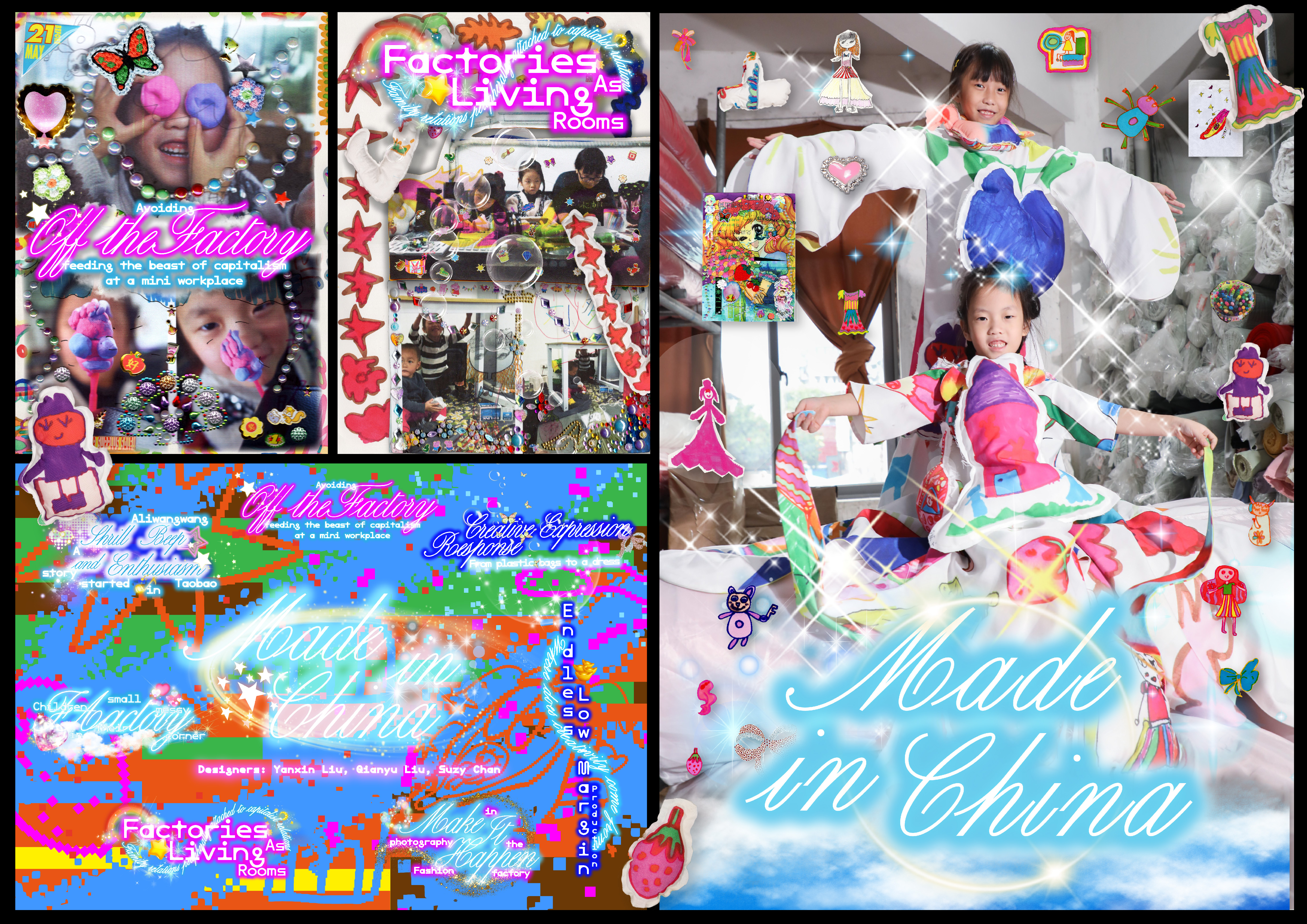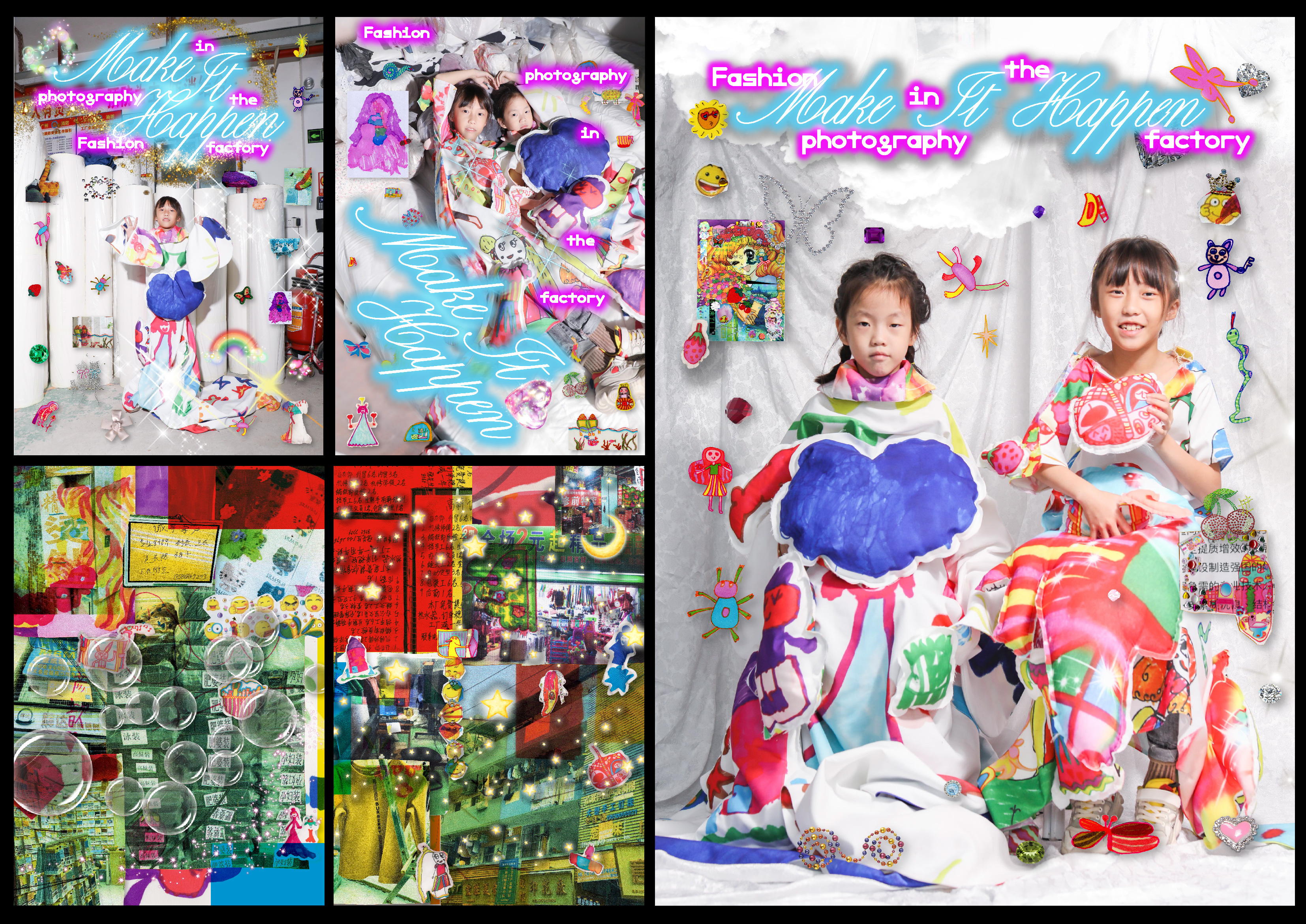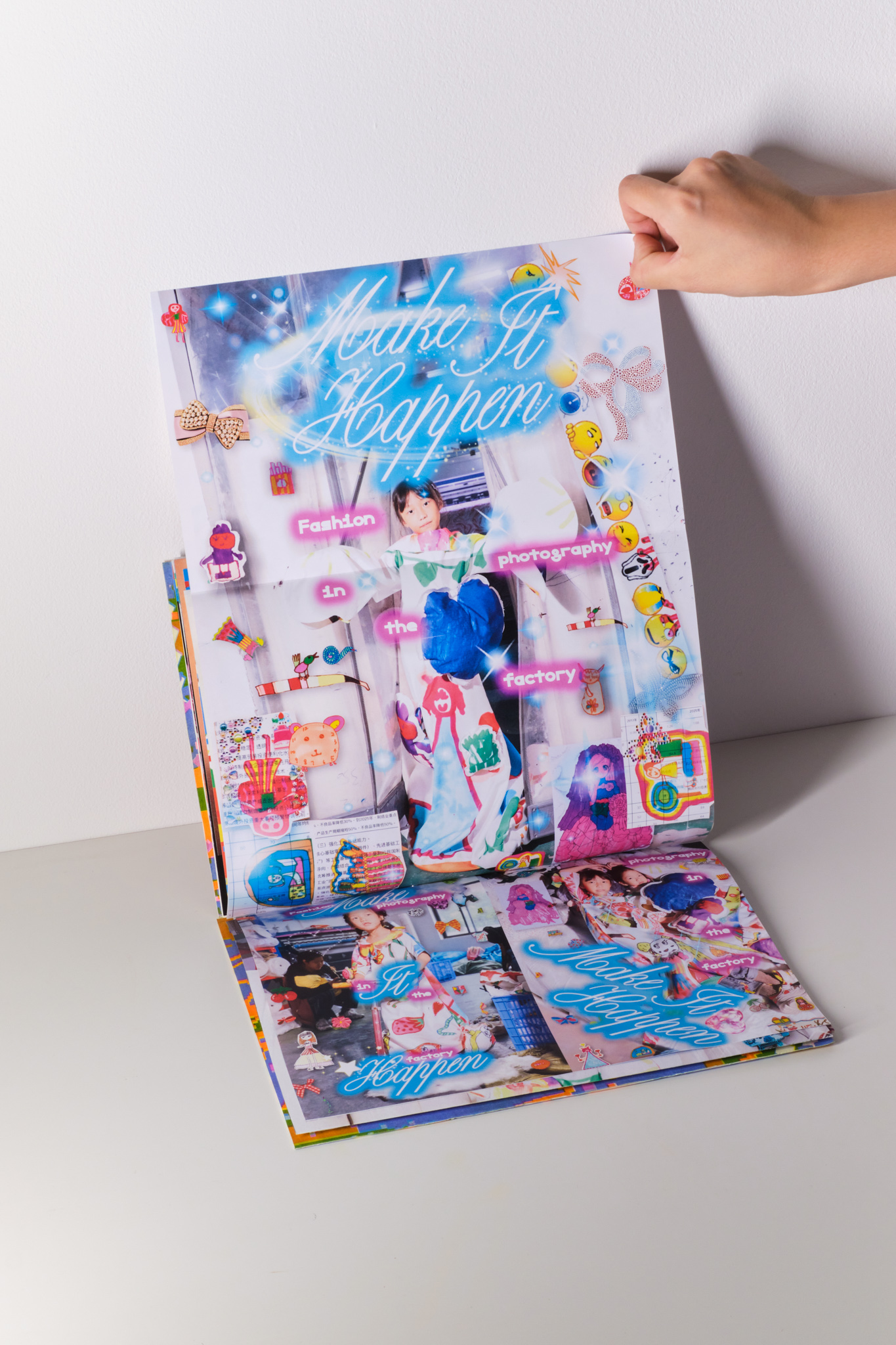
2020-2022
Made in China by Suzy Chan
Brief introduction:
This is a story about a family helping to keep China the largest exporter of goods in the world. The origin of the story is a fabric printing factory in Guangdong, China, one of the birthplaces of “Made in China”. At the factory I met the two daughters of the owner, xinxin and her sister yu. Through them, I explored the neglected family relationships, children's isolation and emotional problems of these factory practitioners behind the "economic miracle" in China.
Full introduction:
In the process of visiting different factories, I always meet many children who are left neglected in the corners. They are all children of people who work in the factories. I've found that their personalities have two extremes, one is very enthusiastic and longing for someone to accompany them. The second is extremely introverted, afraid to communicate with people. Because of their parents' long working hours (often exceeding 12 hours), most of their time out of school is basically spent in the factory. And of course, this phenomenon is more widespread during the holidays. All of this caught my attention.
When the media talks about Made in China, it starts talking about those huge and practical issues. About wages, working hours, left-behind children, labor security, etc. As a country that attaches great importance to family responsibilities, when I talk to many practitioners, I find that the driving force for them to make money is often for the family, especially for their children. Behind the complex economic miracle of China, the motivation of individuals is very simple. But this delicate but more important issue has been overlooked.
A complex topic with many different perspectives: “Made in China” in the Western context always seems to have negative connotations. The West understand “Made in China” products to be low-quality, produced under poor working conditions with excessive working hours, etc. although this understanding is full of various contradictions, and the discussion cannot be completed through simple moral criticism.
In an insecure environment, when these factory owners make money, they want to make more money. But in the process of expanding, they are always playing a game that is bound to lose: No matter whether their business expansion is successful or not, the emotional companionship and education of their children will definitely be missing. So I started to think, with such a huge topic and my limited ability to have an impact here, what can I do for the individual?
In the past two years, I have been going to the factory almost every weekend to see Xinxin and her sister. I think co-creation can be an effective companion so I bring all my painting tools and share with them. From simple painting at the beginning, to complex clothing design later, in the busy factory environment we created a 'mini factory' in the corner; using the resources and environment of the factory to maximize mutual stimulation, transforming high-efficiency industrialized machines into tools that allow them to see their talents. I divided the creative process with them through the past two years into seven stages. And it is presented through writing, photography, graphic, illustration, fashion design, book design.
Graphic Design & Production: Suzy Chan
Illustrators: Yanxin Liu; Qianyu Liu; Suzy Chan
Tailor: Jun Cai
Photography: Nian Xu
Exhibition Photography: Guillaume Valli; Charlie Mead; Joyce Xia
Made in China by Suzy Chan
Brief introduction:
This is a story about a family helping to keep China the largest exporter of goods in the world. The origin of the story is a fabric printing factory in Guangdong, China, one of the birthplaces of “Made in China”. At the factory I met the two daughters of the owner, xinxin and her sister yu. Through them, I explored the neglected family relationships, children's isolation and emotional problems of these factory practitioners behind the "economic miracle" in China.
Full introduction:
In the process of visiting different factories, I always meet many children who are left neglected in the corners. They are all children of people who work in the factories. I've found that their personalities have two extremes, one is very enthusiastic and longing for someone to accompany them. The second is extremely introverted, afraid to communicate with people. Because of their parents' long working hours (often exceeding 12 hours), most of their time out of school is basically spent in the factory. And of course, this phenomenon is more widespread during the holidays. All of this caught my attention.
When the media talks about Made in China, it starts talking about those huge and practical issues. About wages, working hours, left-behind children, labor security, etc. As a country that attaches great importance to family responsibilities, when I talk to many practitioners, I find that the driving force for them to make money is often for the family, especially for their children. Behind the complex economic miracle of China, the motivation of individuals is very simple. But this delicate but more important issue has been overlooked.
A complex topic with many different perspectives: “Made in China” in the Western context always seems to have negative connotations. The West understand “Made in China” products to be low-quality, produced under poor working conditions with excessive working hours, etc. although this understanding is full of various contradictions, and the discussion cannot be completed through simple moral criticism.
In an insecure environment, when these factory owners make money, they want to make more money. But in the process of expanding, they are always playing a game that is bound to lose: No matter whether their business expansion is successful or not, the emotional companionship and education of their children will definitely be missing. So I started to think, with such a huge topic and my limited ability to have an impact here, what can I do for the individual?
In the past two years, I have been going to the factory almost every weekend to see Xinxin and her sister. I think co-creation can be an effective companion so I bring all my painting tools and share with them. From simple painting at the beginning, to complex clothing design later, in the busy factory environment we created a 'mini factory' in the corner; using the resources and environment of the factory to maximize mutual stimulation, transforming high-efficiency industrialized machines into tools that allow them to see their talents. I divided the creative process with them through the past two years into seven stages. And it is presented through writing, photography, graphic, illustration, fashion design, book design.
Graphic Design & Production: Suzy Chan
Illustrators: Yanxin Liu; Qianyu Liu; Suzy Chan
Tailor: Jun Cai
Photography: Nian Xu
Exhibition Photography: Guillaume Valli; Charlie Mead; Joyce Xia
2020-2022
中國製造 by Suzy Chan
簡短介紹:
這是一個關於中國製造背後的家庭的故事。故事的起源地是中國製造的發源地之一中國廣東的一家布料印花工廠。在裡面我碰到了這家工廠的老闆的兩個女兒。 xinxin和她的妹妹yu。通過她們,我探究了在中國製造這一“經濟奇蹟”的背後所被人忽略的家庭培育,子女教育,和這些工廠從業者的子女的情感問題。
完整介紹:
在我探訪不同工廠的過程中總是會遇到很多被忽略在工廠角落的小孩。他們都是在工廠里工作的人的小孩。我發現他們的個性呈現兩個極端,一種是非常熱情,渴望有人可以陪伴他們。第二種是極度的內向,害怕與人交流。而因為他們父母過長的工作時間(最長可能超過12小時),他們除了上學以外的大部分時間基本都是在工廠中度過的。並且這種現象在假期會更常見,所以這引起我的注意。
一旦媒體討論中國製造,就會開始討論那些巨大而實際的問題。比如關於工資、工作時長、留守兒童、勞工保障等等。中國人作為一個重視家庭責任的民族,我跟很多從業者對話時發現對於他們而言掙錢的驅動力往往是為了家庭,尤其是為了他們的子女。在中國這個複雜的經濟奇蹟現象的背後,個體的驅動力卻又非常簡單。但這個細膩卻更重要的問題被忽視了。
在加了各種目的的討論中,當以西方為語境去討論中國製造,西方媒體似乎總是呈現負面的態度。比如關於低質量的產品,糟糕的工作環境,過長的工作時間等等。但裡面其實充滿著各種矛盾,並無法通過簡單的道德批判就完成討論的。
在一個缺少安全感的環境中,當這些工廠老闆賺到了錢,他們就會想要賺更多的錢。但在擴大的過程裡,他們始終在玩一個一定會輸的遊戲:無論他們的生意擴張是否能成功,他們的子女的情感陪伴和教育是一定會缺失的。於是我開始思考,在如此龐大的話題中,和我有限的能力中,我可以為個體做點什麼?
在過去兩年的每週末我幾乎都會去工廠找xinxin和她妹妹。我認為共同創作可以成為一種有效的陪伴方式。於是我帶上我所有的繪畫工具,與他們分享每個週末。從一開始簡單的繪畫,到後來複雜的服裝設計。在繁忙的工廠環境中,我們在工廠的角落自己創造了一個 ‘迷你工作室’,利用工廠的資源和環境,最大化地互相激發,把高效率工業化的機器轉化成讓她們看見自己才能的工具。我將這兩年內與她們一起的創作歷程分為七個階段。並通過攝影、圖形、插圖、時裝設計、書籍設計等方式呈現。
Graphic Design & Production: Suzy Chan
Illustrators: Yanxin Liu; Qianyu Liu; Suzy Chan
Tailor: Jun Cai
Photography: Nian Xu
Exhibition Photography: Guillaume Valli; Charlie Mead; Joyce Xia
中國製造 by Suzy Chan
簡短介紹:
這是一個關於中國製造背後的家庭的故事。故事的起源地是中國製造的發源地之一中國廣東的一家布料印花工廠。在裡面我碰到了這家工廠的老闆的兩個女兒。 xinxin和她的妹妹yu。通過她們,我探究了在中國製造這一“經濟奇蹟”的背後所被人忽略的家庭培育,子女教育,和這些工廠從業者的子女的情感問題。
完整介紹:
在我探訪不同工廠的過程中總是會遇到很多被忽略在工廠角落的小孩。他們都是在工廠里工作的人的小孩。我發現他們的個性呈現兩個極端,一種是非常熱情,渴望有人可以陪伴他們。第二種是極度的內向,害怕與人交流。而因為他們父母過長的工作時間(最長可能超過12小時),他們除了上學以外的大部分時間基本都是在工廠中度過的。並且這種現象在假期會更常見,所以這引起我的注意。
一旦媒體討論中國製造,就會開始討論那些巨大而實際的問題。比如關於工資、工作時長、留守兒童、勞工保障等等。中國人作為一個重視家庭責任的民族,我跟很多從業者對話時發現對於他們而言掙錢的驅動力往往是為了家庭,尤其是為了他們的子女。在中國這個複雜的經濟奇蹟現象的背後,個體的驅動力卻又非常簡單。但這個細膩卻更重要的問題被忽視了。
在加了各種目的的討論中,當以西方為語境去討論中國製造,西方媒體似乎總是呈現負面的態度。比如關於低質量的產品,糟糕的工作環境,過長的工作時間等等。但裡面其實充滿著各種矛盾,並無法通過簡單的道德批判就完成討論的。
在一個缺少安全感的環境中,當這些工廠老闆賺到了錢,他們就會想要賺更多的錢。但在擴大的過程裡,他們始終在玩一個一定會輸的遊戲:無論他們的生意擴張是否能成功,他們的子女的情感陪伴和教育是一定會缺失的。於是我開始思考,在如此龐大的話題中,和我有限的能力中,我可以為個體做點什麼?
在過去兩年的每週末我幾乎都會去工廠找xinxin和她妹妹。我認為共同創作可以成為一種有效的陪伴方式。於是我帶上我所有的繪畫工具,與他們分享每個週末。從一開始簡單的繪畫,到後來複雜的服裝設計。在繁忙的工廠環境中,我們在工廠的角落自己創造了一個 ‘迷你工作室’,利用工廠的資源和環境,最大化地互相激發,把高效率工業化的機器轉化成讓她們看見自己才能的工具。我將這兩年內與她們一起的創作歷程分為七個階段。並通過攝影、圖形、插圖、時裝設計、書籍設計等方式呈現。
Graphic Design & Production: Suzy Chan
Illustrators: Yanxin Liu; Qianyu Liu; Suzy Chan
Tailor: Jun Cai
Photography: Nian Xu
Exhibition Photography: Guillaume Valli; Charlie Mead; Joyce Xia















